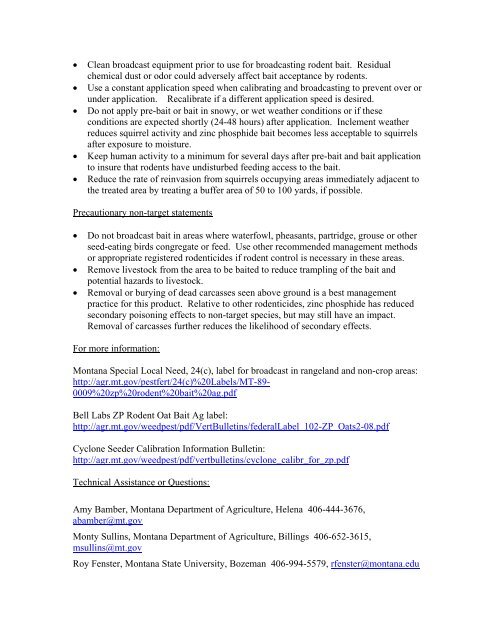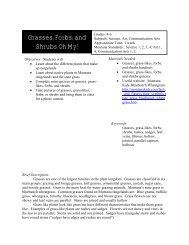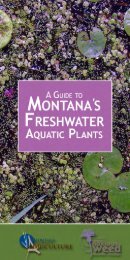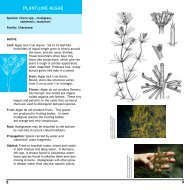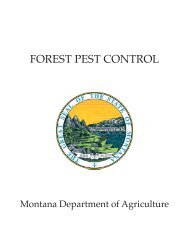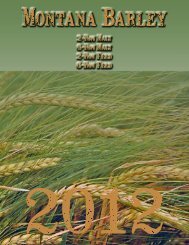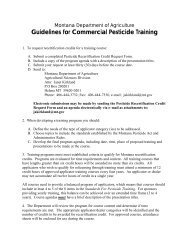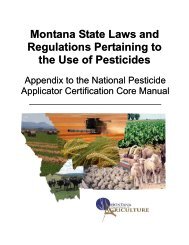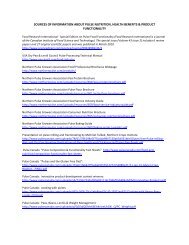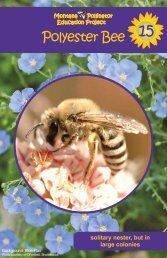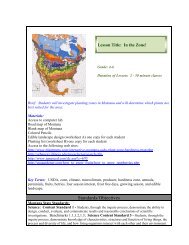Broadcast Use of Zinc Phosphide on Richardson Ground Squirrel
Broadcast Use of Zinc Phosphide on Richardson Ground Squirrel
Broadcast Use of Zinc Phosphide on Richardson Ground Squirrel
Create successful ePaper yourself
Turn your PDF publications into a flip-book with our unique Google optimized e-Paper software.
• Clean broadcast equipment prior to use for broadcasting rodent bait. Residualchemical dust or odor could adversely affect bait acceptance by rodents.• <str<strong>on</strong>g>Use</str<strong>on</strong>g> a c<strong>on</strong>stant applicati<strong>on</strong> speed when calibrating and broadcasting to prevent over orunder applicati<strong>on</strong>. Recalibrate if a different applicati<strong>on</strong> speed is desired.• Do not apply pre-bait or bait in snowy, or wet weather c<strong>on</strong>diti<strong>on</strong>s or if thesec<strong>on</strong>diti<strong>on</strong>s are expected shortly (24-48 hours) after applicati<strong>on</strong>. Inclement weatherreduces squirrel activity and zinc phosphide bait becomes less acceptable to squirrelsafter exposure to moisture.• Keep human activity to a minimum for several days after pre-bait and bait applicati<strong>on</strong>to insure that rodents have undisturbed feeding access to the bait.• Reduce the rate <str<strong>on</strong>g>of</str<strong>on</strong>g> reinvasi<strong>on</strong> from squirrels occupying areas immediately adjacent tothe treated area by treating a buffer area <str<strong>on</strong>g>of</str<strong>on</strong>g> 50 to 100 yards, if possible.Precauti<strong>on</strong>ary n<strong>on</strong>-target statements• Do not broadcast bait in areas where waterfowl, pheasants, partridge, grouse or otherseed-eating birds c<strong>on</strong>gregate or feed. <str<strong>on</strong>g>Use</str<strong>on</strong>g> other recommended management methodsor appropriate registered rodenticides if rodent c<strong>on</strong>trol is necessary in these areas.• Remove livestock from the area to be baited to reduce trampling <str<strong>on</strong>g>of</str<strong>on</strong>g> the bait andpotential hazards to livestock.• Removal or burying <str<strong>on</strong>g>of</str<strong>on</strong>g> dead carcasses seen above ground is a best managementpractice for this product. Relative to other rodenticides, zinc phosphide has reducedsec<strong>on</strong>dary pois<strong>on</strong>ing effects to n<strong>on</strong>-target species, but may still have an impact.Removal <str<strong>on</strong>g>of</str<strong>on</strong>g> carcasses further reduces the likelihood <str<strong>on</strong>g>of</str<strong>on</strong>g> sec<strong>on</strong>dary effects.For more informati<strong>on</strong>:M<strong>on</strong>tana Special Local Need, 24(c), label for broadcast in rangeland and n<strong>on</strong>-crop areas:http://agr.mt.gov/pestfert/24(c)%20Labels/MT-89-0009%20zp%20rodent%20bait%20ag.pdfBell Labs ZP Rodent Oat Bait Ag label:http://agr.mt.gov/weedpest/pdf/VertBulletins/federalLabel_102-ZP_Oats2-08.pdfCycl<strong>on</strong>e Seeder Calibrati<strong>on</strong> Informati<strong>on</strong> Bulletin:http://agr.mt.gov/weedpest/pdf/vertbulletins/cycl<strong>on</strong>e_calibr_for_zp.pdfTechnical Assistance or Questi<strong>on</strong>s:Amy Bamber, M<strong>on</strong>tana Department <str<strong>on</strong>g>of</str<strong>on</strong>g> Agriculture, Helena 406-444-3676,abamber@mt.govM<strong>on</strong>ty Sullins, M<strong>on</strong>tana Department <str<strong>on</strong>g>of</str<strong>on</strong>g> Agriculture, Billings 406-652-3615,msullins@mt.govRoy Fenster, M<strong>on</strong>tana State University, Bozeman 406-994-5579, rfenster@m<strong>on</strong>tana.edu


